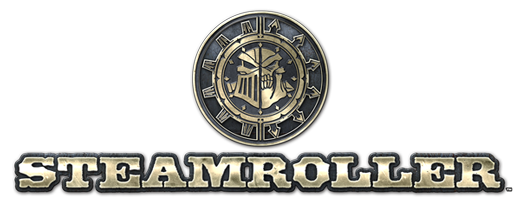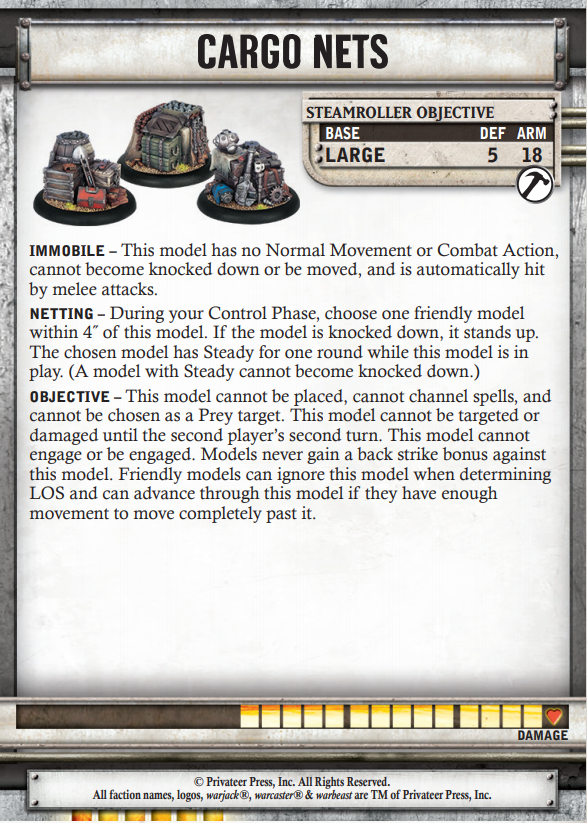by Faye Reppas
After a break for all of us to deal with unfortunate world events, Steamroller 2021 intorduces a nice shake-up for tournament play in WARMACHINE and HORDES. In this Insider, I’ll go over what has changed since the Community Integrated Development (CID) and some of the development reasons for those changes. To get caught up, check out this insider with an overview on the changes before the CID.
Let’s start with scenarios, as they experienced the least changes from before the CID. King of the Hill, Spread the Net, and Bunkers all received minor changes that were extremely well received.
The new scenario, Split Decision, received two minor adjustments. First, it was proving to be a little too “live,” which in this context means the scenario elements proved too easy to score and, by contrast, too difficult to protect. We pushed the flags and objectives on the right side of the map 2˝ toward the vertical center line and toward each player’s table edge to help slow the scenario down a little. It also has the added benefit of getting the objective closer to the center of the action, making whichever objective you choose a little more powerful in this scenario.
The other change was to add the nonsymmetrical rule. This really isn’t a rule so much as a clarifying statement. Several people were confused about how the scenario was set up because it is nonsymmetrical on the vertical axis, the first of its kind in Steamroller. The rule simply clarifies that the scenario elements are not dependent on the table side each player chooses; instead, the scenario should be set up before rolling for the first turn and choosing table sides.
Now to get into some more juicy changes…
The Shrine objective had gone through a few iterations and was just not cutting it. It started out giving a model Aegis, then moved to letting one model shake a shakable effect (like warjacks can), but that too proved to be not quite right. So, taking the concerns about an objective empowering already-powerful models like archons and battle engines to heart, I came up with Cargo Nets.
Cargo Nets is a bit of a combination of the last two versions of the Shrine. It lets a model “shake” knock down by causing it to stand up. In addition, it gives that model steady for one round. Be sure to focus on the last few words “…while this model is in play.” Those words are doing a lot of work here. If Cargo Nets is destroyed, the model benefitting from it will immediately lose steady. Steady on any model is rather powerful, so adding a way to get rid of it by destroying the objective was rather crucial.
Many eagle-eyed readers will notice the conspicuous lack of the word “Faction” from the Cargo Nets card. I axed the requirement that objectives target Faction models with their abilities—this is more a quality-of-life change than anything else. Since the rest of the objectives’ abilities worked on non-Faction models, it just made sense these abilities would as well.
Moving right along to terrain, we made several small adjustments to terrain during the CID and a few afterward as well. Before I get into that, I want to go over some of my thought process as a developer with new terrain. These terrain features should be able to be described in one or two simple sentences. For example, Burning Earth—it is rough terrain that lights models on fire. A simple, quick-to-understand concept. Many people were asking for very complex interactions in their terrain, and that just would not work well for what terrain should be doing.
With that in mind, let’s start with the terrain features that stayed the same. Tall Grass and Open Graves didn’t get any changes. They proved to be sufficiently different from normal terrain and therefore didn’t need to function differently from how they went into CID.
Now on to Windstorm, which ended up being renamed Squall. This terrain feature only received one change: making it a cloud effect in addition to the reduction to range. Some wanted this to mess with flying models as well, and I listened to that feedback. As mentioned above, however, I felt that was too much to put into one terrain feature. Remember, keep it one simple sentence: cloud effect that reduces the range of ranged attacks. It has a very consistent through line.
To differentiate Crater from Open Graves, trenches, and rubble it became rough terrain. This gives it a nice niche. It is a bit of a mix of all of those other three terrain types: rough terrain, grants cover, protects from blasts, and is irregularly shaped.
Although Quicksand didn’t get any functionality changes, Crater and Quicksand both got a quality-of-life change people were asking for. They are now described as “irregularly shaped and often circular” with an approximate area no larger than a 5˝ diameter circle. They shouldn’t be massive pieces of terrain, but at the same time, not every pool of quicksand is a circle, and not all craters exist on their lonesome.
Finally, coming in as a bit of a surprise is Windswept. This is a hazard that can be applied to any rough terrain. Remember when I said I was listening to people’s concerns about flying models? Windswept is my answer to that. Flying models, including those benefitting from rules like Ghostly or Incorporeal, move at half-rate while moving through a Windswept piece of terrain. The reason a model is affected by Windswept despite having pathfinder, ghostly, or incorporeal is due to its nature as a hazard; hazard effects are not terrain effects. Just like with Burning Earth and Acid Pool, when applying a hazard to a terrain feature it also becomes restricted, so don’t put too many of these out there. Just the same, a Windswept piece of terrain near the middle of the table will really change things for those flying too close to the sun.
There is one other change I know people will rejoice over: circular zones no longer require warrior units to score them. Any old unit will do. This was brought up early in the CID and was removed as off-topic (because it was), but there was always a plan to remove this from the packet. That said, minor changes like this that allow two more units to score zones don’t need to be playtested and really have no place in CID. (This logic also applies to the removal of the Faction tag from the objectives’ abilities.)
And that’s it for the big changes to Steamroller—there were some other minor updates (i.e., cutting words like “hills” from the document, because as we all know hills don’t exist), but those types of changes won’t really change anyone’s tournament experience, so you’ll just have to find them yourselves over time.
Now go out there and find a Steamroller event near you!
Steamroller Rules 2021_v4



